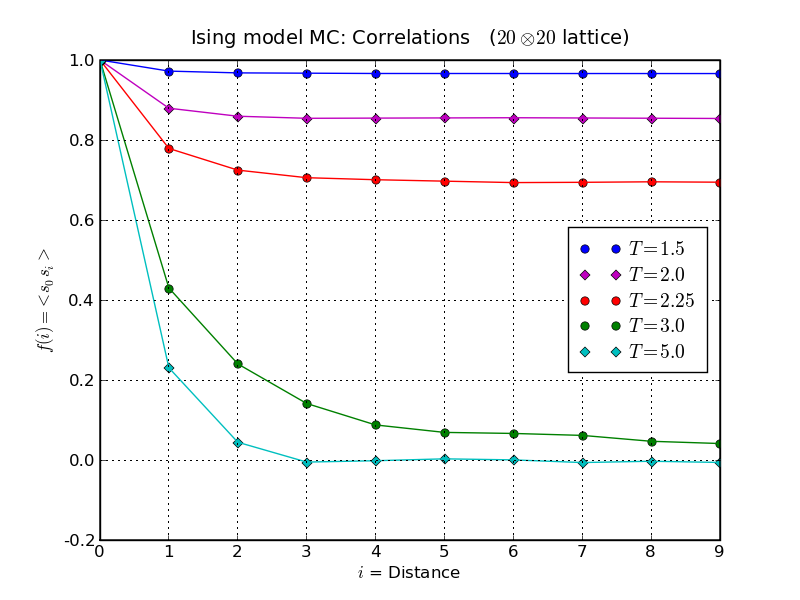
In the previous graph of energy vs. temperature, the energy per spin became less negative under the randomising effect of temperature. It would be expected that the energy becomes zero at temperatures above Tc, since there is no net magnetic moment, and therefore equal amounts of 'spin up' and 'spin down'. However, after the occurence of the phase change at \( T_c \), the energy per spin still remained negative. This suggests that there is still some residual alignment with the spins and their neighbours even as temperatures become much greater than \(T_c \). This is what we define as correlations. This occurs because the randomising effect of temperature is not strong enough to create a completely random alignment between neighbouring spins.
In order to quantify the residual alignment of the spins, an initial spin
is selected, and labelled s0. The correlation function is
found between the initial spin and a second spin, si, which is
i lattice sites away from s0. This correlation finction,
f(i), is then calculated through the equation
\( f(i)=\langle s_0 s_i \rangle \). In a Monte Carlo simulation, every spin is
used as an s0, and the correlation function is determined for
all other spins. This ensures that all pairs of spins are investigated, over
many time steps. This way the average of the product can be best evaluated.
These are the results for the correlation function for a 20 × 20 lattice
plotted at different temperatures.

This behaviour of the correlation function can be further described at large distances from the central spin as exponential decay,
\[ f(i) \sim C_1 + C_2 \exp(-r_i/ \xi )\,\, . \]ξ is the correlation length, a measure of the range
over which the correlations of spin-fluctuations, (s-⟨s⟩),
approach zero.
As the separation between two spins, ri, tends to infinity,
s0 and si become uncorrelated. Therefore the
product of the average values of the two spins is equal to the
average value of the entire system squared, ⟨s⟩2.
The correlation function therefore becomes
As this is taken in the limit \(r_i \longrightarrow \infty \), it can also
shown by comparison that C1=⟨s⟩2.
This allows us to rearrange to obtain
From the results for the correlation function at varying temperatures, it can
be seen that ξ is a function of temperature.
In the limit of large lattices, ξ can be seen to diverge at
Tc according to the power law,
with the critical exponent ν.
When T=Tc, ξ becomes infinite.
This infinite correlation length means that all of the spins in the system are
sensitive to every other spin. At this point of infinite ξ, the
correlations alter as a power law function of the distance, ri.
We have shown that while the total magnetic moment of a system at a temperature above Tc is zero, there is still some correlation between neighbouring spins. This leads us to the conclusion that the average alignment of near neighbours is different from the average alignment of the entire system. This effect is not taken into account in mean field theory, which completely ignores local fluctuations and therefore does not give an accurate description of the system at temperatures around Tc.